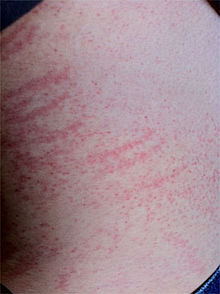Airbag dermatitis (also known as an "airbag burn") is skin irritation secondary to the deployment of airbags.[1][2] The diagnosis of "air bag dermatitis" is relatively recent;[3] the first case was reported in 1994.[4]
| Airbag dermatitis | |
|---|---|
 | |
| Dermatitis symptoms on trunk. | |
| Specialty | Dermatology |
Signs and symptoms edit
It appears that cutaneous traumatic lesions are highly prevalent: in a retrospective study, the specific injuries observed were 63.6%, 37.8%, and 18.2%, respectively, consisting of abrasions, contusions, and lacerations.[5] The sudden inflation of the airbag, which strikes the chest or traps the hands and forearms between the steering wheel and the airbag itself, can result in traumatic lesions. Traumatic lesions can be superficial abrasions that heal on their own or deep, large lacerations that need to be sutured.[6] Often, "friction burns" occur, especially on the face. The unfolding airbag can cause multiple superficial parallel lesions with its slapping action.[7][8]
Usually, irritant contact dermatitis affects the face, arms, and upper chest. It is characterized as purpuric aspects and erythema and swelling. Patients report stinging and burning feelings in the afflicted areas. A combination of gases, abrasive powders, and even talc released under pressure can cause irritant dermatitis. Irritant contact dermatitis typically goes away in a few days and appears to be superficial. Common aftereffects include desquamative and post-inflammatory hyperpigmentation.[9]
See also edit
References edit
- ^ Rapini, Ronald P.; Bolognia, Jean L.; Jorizzo, Joseph L. (2007). Dermatology: 2-Volume Set. St. Louis: Mosby. p. 1357. ISBN 978-1-4160-2999-1.
- ^ James, William D.; et al. (2006). Andrews' Diseases of the Skin: Clinical Dermatology. Saunders Elsevier. ISBN 0-7216-2921-0.
- ^ Foley, Sharon; Mallory, Susan B (1995). "Air bag dermatitis". Journal of the American Academy of Dermatology. 33 (5). Elsevier BV: 824–825. doi:10.1016/0190-9622(95)91840-x. ISSN 0190-9622. PMID 7593785.
- ^ Burton, J L (March 1, 1994). "Air-bag injury". Emergency Medicine Journal. 11 (1). BMJ: 60. doi:10.1136/emj.11.1.60-a. ISSN 1472-0205. PMC 1342382. PMID 7921556.
- ^ Antosia, Robert E; Partridge, Robert A; Virk, Alamjit S (1995). "Air Bag Safety". Annals of Emergency Medicine. 25 (6). Elsevier BV: 794–798. doi:10.1016/s0196-0644(95)70210-5. ISSN 0196-0644. PMID 7755203.
- ^ Corazza, Monica; Trincone, Silvana; Virgili, Annarosa (2004). "Effects of Airbag Deployment". American Journal of Clinical Dermatology. 5 (5). Springer Science and Business Media LLC: 295–300. doi:10.2165/00128071-200405050-00002. ISSN 1175-0561. S2CID 12430586.
- ^ Baruchin, A.M; Jakim, I; Rosenberg, L; Nahlieli, O (1999). "On burn injuries related to airbag deployment". Burns. 25 (1). Elsevier BV: 49–52. doi:10.1016/s0305-4179(98)00110-7. ISSN 0305-4179. PMID 10090384.
- ^ Hallock, Geoffrey G. (1997). "Mechanisms of Burn Injury Secondary to Airbag Deployment". Annals of Plastic Surgery. 39 (2). Ovid Technologies (Wolters Kluwer Health): 111–113. doi:10.1097/00000637-199708000-00001. ISSN 0148-7043. PMID 9262762. S2CID 46375923.
- ^ Norton, Scott A. (October 1, 2002). "Candy's Dandy but Cantharidin's Quicker". Archives of Dermatology. 138 (10). American Medical Association (AMA): 1378. doi:10.1001/archderm.138.10.1378. ISSN 0003-987X. PMID 12374552.